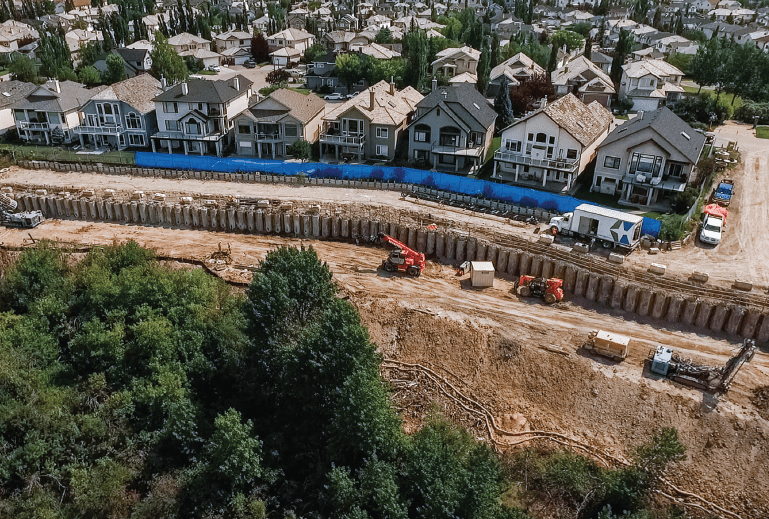
In November 2017, Pomerleau awarded Doublestar Drilling (DSD) the Douglasdale-McKenzie Lake Slope Stabilization & Pathway Project located in Calgary, Alta., on the banks of the Bow River. DSD was responsible for supplying and installing 236 cast-in-place (CIP) concrete piles, 234 rock anchors, 225 micropiles, 800 m2 of shotcrete and the installation of geotechnical instruments: Slope Inclinometers and CSL Tubes.
This diverse scope of work required an immense amount of pre-project planning between DSD and Pomerleau to ensure that the design requirements, safety and site specifications were compliant with The City of Calgary Standards. Due to the environmental sensitivity factors of this project, DSD took every precaution available to guarantee that all risks were mitigated to prevent any potential environmental impacts.
Equipped with special sound dampeners on the Kelly bars and the engine silencer kits on the Liebherr drilling rigs, noise levels were minimized for the surrounding residential communities. It was critical to the design that the equipment didn’t exceed 200 kilopascals of downward pressure on the drilling platform. Therefore, DSD carefully chose their Liebherr drill rigs and crawler crane to ensure this requirement was met throughout the project.
First, DSD completed the 165-millimetre-diameter micropiles that were installed in four months with a 32 mm DSI threadbar using their Davey Kent 725 and Interoc AN150 drill rigs. DSD equipped their rigs with solid stem and air rotary tooling applications in order to complete approximately 3,465 metres of total drilled depths.
DSD selected the Liebherr LB-28 drill rigs to complete the CIP piles due to their powerful torque and crowd capabilities, eliminating any need for vibratory and/or slurry drilling methods. Their Liebherr HS855 HD crawler crane was utilized for lifting and tying cages onsite. In just over six months, DSD’s piling crew completed the 236 914-mm-diameter CIP piles to depths of 32 m and moved their focus to the remaining rock anchors and shotcrete.
Prior to drilling, DSD completed pre-production rock anchors, which were stressed up to 200 per cent of the design load, to determine the remaining anchors’ design capacity and validate the anchor bond parameters.
Going forward, all anchors are to be proof tested to 133 per cent of the design load of 650 kilonewtons and installed with a 46-mm double corrosion protected threadbar. The 150-mm-diameter anchors are being installed to depths of 32 m which will be completed by DSD’s HUTTE HBR610 drill. Currently, about 95 rock anchors have been completed and DSD continues to prepare the installation of the remaining anchors and shotcrete to complete this project on time and on budget.